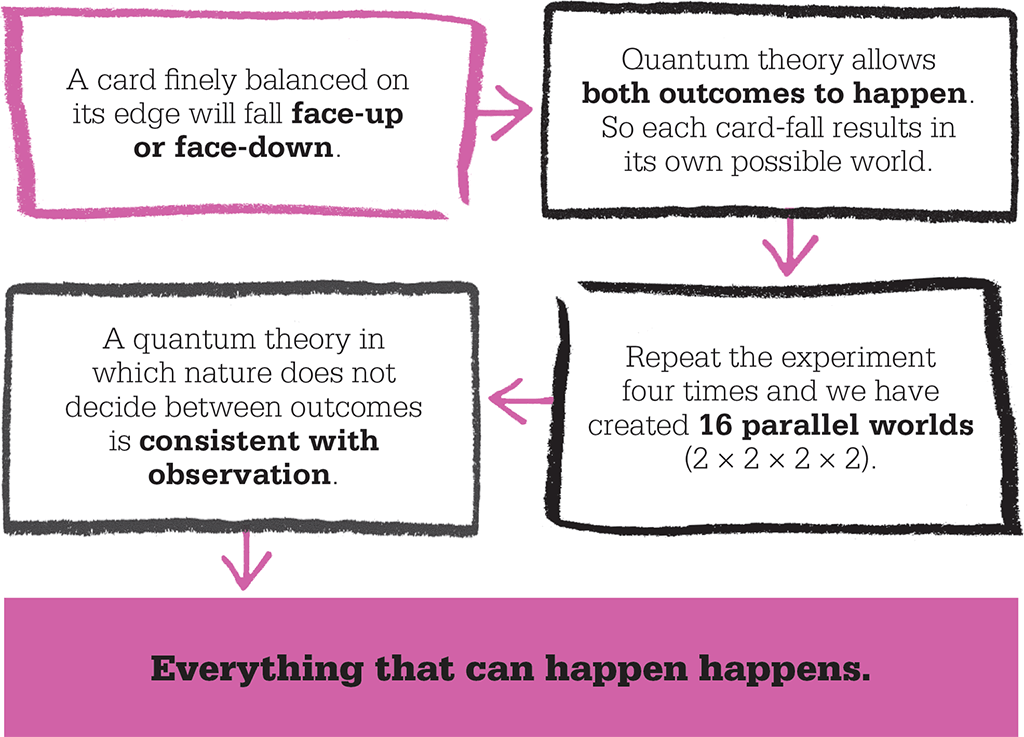
IN CONTEXT
Physics and cosmology
1600 Italian philosopher Giordano Bruno is burned at the stake for his belief in an infinity of inhabited worlds.
1924–27 Niels Bohr and Werner Heisenberg seek to resolve the measurement paradox of wave-particle duality by invoking a wavefunction collapse.
1980s A principle known as decoherence attempts to provide a mechanism by which the many-worlds interpretation may work.
2000s Swedish cosmologist Max Tegmark describes an infinity of universes.
2000s In quantum computer theory, computational power is sourced from superpositions that are not in our universe.
Hugh Everett III is a cult figure to sci-fi enthusiasts because his many-worlds interpretation (MWI) of quantum mechanics changed scientists’ ideas about the nature of reality.
Everett’s work was inspired by the embarrassing flaw at the heart of quantum mechanics. Although it can explain interactions at the most fundamental level of matter, quantum mechanics also produces bizarre results that seem to be at odds with experiment, a dichotomy at the heart of the measurement paradox.
In the quantum world, subatomic particles are allowed to exist in any number of possible states of location, velocity, and spin, or “superpositions”, as described by Erwin Schrödinger’s wavefunction, but the phenomenon of many possibilities disappears as soon as it is observed. The very act of measuring a quantum system seems to “shunt” it into one state or another, forcing it to “choose” its option. In the world we’re familiar with, a coin toss results in a definite heads or tails, and not one, the other, and both at once.

Copenhagen fudge
In the 1920s, Niels Bohr and Werner Heisenberg attempted to sidestep the measurement problem with what became known as the Copenhagen interpretation. It holds that the act of making an observation on a quantum system causes the wavefunction to “collapse” into the single outcome. Although this remains a widely accepted interpretation, many theorists find it unsatisfactory since it reveals nothing about the mechanism of wavefunction collapse. This bothered Schrödinger, too. For him, any mathematical formulation of the world had to have an objective reality. As Irish physicist John Bell put it, “Either the wavefunction, as given by the Schrödinger equation, is not everything, or is not right.”

“Multiverse” is an installation of 41,000 LED lights at the National Gallery of Art in Washington DC. It was inspired by the many-worlds interpretation.
Many worlds
Everett’s idea was to explain what happens to the quantum superpositions. He presumed the objective reality of the wavefunction and removed the (unobserved) collapse – why should nature “choose” a particular version of reality every time someone makes a measurement? He then asked another question: what then happens to the various options available to quantum systems? The MWI says that all possibilities do, in fact, occur. Reality peels itself, or splits, into new worlds, but since we inhabit a world where only one outcome occurs, this is what we see. Other possible outcomes are inaccessible to us, since there can be no interference between worlds and we are fooled into thinking that something is lost every time we measure something.
While Everett’s theory is not accepted by all, it removes a theoretical block to interpreting quantum mechanics. MWI does not mention parallel universes, but they are its logical prediction. It has been criticized for being untestable, but this may change. An effect known as “decoherence” – whereby quantum objects “leak” their superposition information – is a mechanism by which MWI might be proved to work.
HUGH EVERETT III
Born in Washington DC, Hugh Everett was a precocious boy. Aged 12, he wrote to Einstein asking what held the Universe together. While he was studying mathematics at Princeton, he drifted into physics. MWI – his answer to the riddle at the heart of quantum mechanics – was the subject of his PhD in 1957, and led to him being pilloried for proposing multiple universes. A trip to Copenhagen in 1959 to discuss the idea with Niels Bohr was a disaster – Bohr rejected everything that Everett said. Discouraged, he left physics for the US defence industry, but today MWI is regarded as a mainstream interpretation of quantum theory – too late for Everett, an alcoholic, who died aged just 51. A life-long atheist, he asked for his ashes to be thrown out with the rubbish.
Key works
1956 Wave Mechanics Without Probability
1956 The Theory of the Universal Wave Function
See also: Max Planck • Werner Heisenberg • Erwin Schrödinger